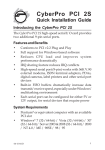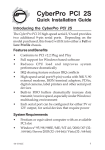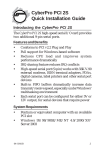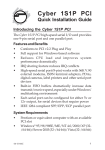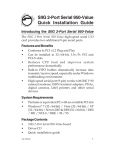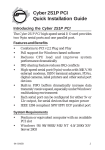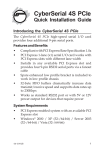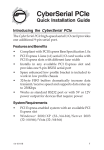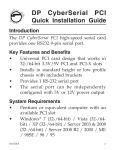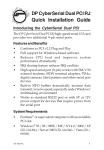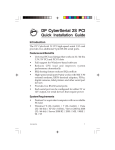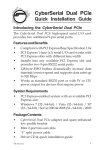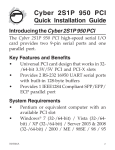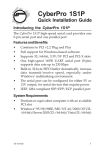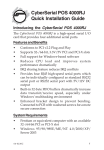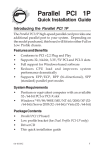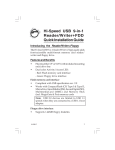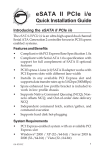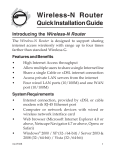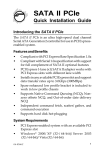Download Siig Two-port serial (16550) I/O card
Transcript
CyberPro PCI 2S Quick Installation Guide Introducing the CyberPro PCI 2S The CyberPro PCI 2S high-speed serial I/O card provides two additional 9-pin serial ports. Depending on the model purchased, this board will fit into either a Full or Low Profile chassis. Features and Benefits • • • • • • • Conforms to PCI v2.2 Plug and Play Full support for Windows-based software Reduces CPU load and improves system performance dramatically IRQ sharing feature reduces IRQ conflicts High-speed serial port (9-pin) works with 56K V.90 external modems, ISDN terminal adapters, PDAs, digital cameras, label printers and other serial port devices Built-in FIFO buffers dramatically increase data transmit/receive speed, especially under Windows' multitasking environment Each serial port can be configured for either 5V or 12V output, for serial devices that require power System Requirements • • Pentium® or equivalent computer with an available PCI slot Windows® 7 (32-/64-bit) / Vista (32-/64-bit) / XP (32-/64-bit) / Server 2003 & 2008 (32-/64-bit) / 2000 / NT 4.0 / ME / 98SE / 98 / 95 04-0342D 1 Package Contents • • • • • CyberPro PCI 2S board 2-port fan-out cable Spare Low profile bracket (for Dual Profile board) Driver CD Quick installation guide Layout Full profile bracket* JP2 (Serial port 2) Fan-out cable connector (25-pin) JP1 (Serial port 1) Figure 1. Layout * Note: Depending on the model purchased, the bracket size will be either Full or Low profile. Jumper Settings (JP1, JP2) Open = 0 volts (default) Short 1-2 = 5V Short 2-3 = 12V Note: Most serial devices do not require additional power through the serial port. Refer to your serial device's manual for more information. 2 2-port Fan-out Cable 9-pin serial 25-pin connector 9-pin serial Figure 2. 2-port Fan-out Cable Hardware Installation General instructions for installing the card are provided below. Since the design of computer cases and motherboards vary, refer to your computer’s reference manual for further information, if needed. Static Electricity Discharge may permanently damage your system. Discharge any static electricity build up in your body by touching your computer’s case for a few seconds. Avoid any contact with internal parts and handle cards only by their external edges. 1. 2. 3. 4. Turn OFF the power to your computer and any other connected peripheral devices. Unplug the power cord from the back of the computer. Remove your computer’s cover. Remove the slot bracket from an available PCI slot. 3 5. 6. 7. 8. 9. Set JP1 and JP2 jumper settings to the desired voltage only if your serial device needs additional power from the serial port. However, most serial devices do not require additional power. For more information see Figure 1 on page 2. The jumpers can be removed if power is not required. To install the card, carefully align the card's bus connector with the selected PCI slot on the motherboard. Push the board down firmly, but gently, until it is well seated. Replace the slot bracket holding screw to secure the card. Replace the computer cover and reconnect the power cord. Connect the 2-port fan-out cable to the board's 25-pin connector. See Figure 2 on page 3 for more details. Driver Installation Make sure the board is installed into the computer before proceeding. Windows 7 (32-/64-bit) 1. 2. 3. 4. 5. 4 Right click Computer, click Manage, click Device Manager. Insert the driver CD. Right click PCI Serial Port, click Update Driver Software. Click Browse my computer for driver software. Type D:, then click Next. (Change D: to match your CD/DVD-ROM drive letter) At Windows has successfully updated your driver software, click Close. 6 Right click Other PCI Bridge Device, click Update Driver Software. 7. Repeat steps 3-5. 8. Right click CyberSerial Communication Port, click Update Driver Software. 9. Click Browse my computer for driver software. 10. Type D:, click Next. (Change D: to match your CD/ DVD-ROM drive letter) 11. At Windows has successfully updated your driver software, click Close. 12. Repeat steps 8-11 to complete the installation. Windows Vista™ (32-/64-bit) 1. 2. 3. At the Found New Hardware window, insert the driver CD, click Locate and install driver software (recommended), then click Continue. Click Next, then click Close. Repeat step 2 to complete the driver installation. Note: Windows Vista driver installation process may take several minutes to complete. Windows XP / Server 2003 (32-/64-bit) 1. 2. 3. 4. 5. 6. At the Found New Hardware Wizard, insert the driver CD. Select No, not this time, click Next. (Skip this step if not prompted) Select Install the software automatically (Recommended), then click Next. Click Finish. Repeat steps 1-4 two more times. Restart Windows to complete the installation. 5 Windows Server 2008 (32-/64-bit) 1. 2. 3. 4. 5. 6. 7. 8. At the Found New Hardware Wizard, click Locate and install driver software (recommended). Insert the driver CD. Click Don't search online. Click I don't have the disc. Show me other options. Click Browse my computer for driver software (advanced). Type D:, then click Next. (Change D: to match your CD/DVD-ROM drive letter) At The sofware for this device has been sucessfully installed, click Close. Repeat steps 3-7 to complete the installation. To Verify Windows 7 / Vista / XP / Server 2003 & 2008 Installation 1. 2. 3. 6 Check in Device Manager to verify installation. For Windows 7: Right click Computer, click Manage, then click Device Manager. For Windows Vista: Right click Computer, click Manage, click Continue, then click Device Manager. For XP / Server 2003: Right click My Computer, click Manage, then click Device Manager. For Server 2008: Right click Computer, click Manage, double click Diagnostics, then click Device Manager. Click on the + (plus sign) in front of Ports (COM & LPT), CyberSerial 16Cxxx... should be displayed two times. Double click Multifunction adapters, SIIG CyberPro 2S board should be displayed. Windows 2000 1. 2. 3. 4. 5. 6. 7. At the Found New Hardware Wizard, click Next. Select Search for a suitable driver for my device (recommended), then click Next. Check Specify a location, uncheck the other boxes, then click Next. Insert the driver CD, type in D:\2000, then click OK. (Change D: to match your CD-ROM drive letter) Click Next and Finish. Repeat steps 1-5 two more times. Restart Windows to complete the installation. To Verify Windows 2000 Installation 1. 2. 3. Right click My Computer, click Manage, then click Device Manager. Click on the + (plus sign) in front of Ports (COM & LPT), CyberSerial 16Cxxx... should be displayed two times. Double click Multifunction adapters, SIIG CyberPro 2S board should be displayed. Windows ME 1. 2. 3. 4. At the Add New Hardware Wizard, select Specify the location of the driver (Advanced), then click Next. Insert the driver CD, check Specify a location, uncheck the other box, type in D:\ME, then click Next. (Change D: to match your CD/DVD-ROM drive letter) Click Next, then Finish. Repeat steps 1 and 2. 7 5. 6. Click Next, Next, then Finish. Restart Windows to complete the installation. Windows 98 / 98SE 1. 2. 3. 4. 5. 6. At the Add New Hardware Wizard, click Next. Select Search for the best driver for your device (Recommend), then click Next. Insert the driver CD, check Specify a location, uncheck the other boxes, type in D:\9x, then click Next. (Change D: to match your CD/DVD-ROM drive letter) Click Next, then Finish. Repeat steps 1-4. Restart Windows to complete the installation. Windows 95 1. 2. 3. 4. 5. At the Update Device Driver Wizard, click Next. Insert the driver CD, click Other Locations. Type in D:\9x, click OK, then click Finish. (Change D: to match your CD/DVD-ROM drive letter) From the Insert Disk window, click OK. When the Copying Files dialog box pops up, type in D:\9x, then click OK. (Change D: to match your CD/DVDROM drive letter) Restart Windows to complete the installation. To Verify Windows ME / 98SE / 98 / 95 Installation 1. 2. 8 Right click My Computer, click Properties, then click Device Manager. Double click Ports (COM & LPT), CyberSerial PCI 16Cxxx... should be displayed two times. 3. Double click Multi-function adapters, SIIG CyberPro 2S... and PCI Function should be displayed. Windows NT 4.0 1. 2. 3. 4. 5. 6. From the desktop click Start, then Run. Insert the driver CD, type in D:\NT4\Install_serial.exe, then click OK. (Change D: to match your CD/DVD-ROM drive letter) Click Next when the Welcome window appears. Select Install, then click Next. Click Yes, then click Exit. Restart Windows to complete the installation. To Verify Windows NT 4.0 Installation 1. 2. Click Start, Settings, Control Panel. Double click Ports device icon. Two new COM ports will be assigned when successfully installed. 9 Changing COM Port Address Some serial devices need a specific COM port in order to work. If your serial device works properly, do not change this setting. Windows 7 / Vista / XP / Server 2003 & 2008 / 2000 1. 2. 3. 4. From the Device Manager window double click Ports (COM & LPT), then double click the CyberSerial serial port you want to change. Click Settings tab and click Advanced. Click the down arrow that is next to the COM Port number box and select a COM port that is not in use. Click OK. Click OK, then close Device Manager to save the changes. Windows ME / 98SE / 98 / 95 1. 2. 3. 10 From the Device Manager window double click Ports (COM & LPT), then double click the CyberSerial PCI serial port you want to change. Click Settings tab, click the down arrow that is next to the Port Name box and select a COM address that is not currently in use. Click OK, then close Device Manager to save the changes. Technical Support and Warranty QUESTIONS? SIIG’s Online Support has answers! Simply visit our web site at www.siig.com and click Support. Our online support database is updated daily with new drivers and solutions. Answers to your questions could be just a few clicks away. You can also submit questions online and a technical support analysts will promptly respond. SIIG offers a lifetime manufacturer warranty with this product. Please see our web site for more warranty details. If you encounter any problems with this product, please follow the procedures below. A) If it is within the store's return policy period, please return the product to the store where you purchased from. B) If your purchase has passed the store's return policy period, please follow these steps to have the product repaired or replaced. Step 1: Submit your RMA request. Go to www.siig.com, click Support, then RMA to submit a request to SIIG RMA. If the product is determined to be defective, an RMA number will be issued. Step 2: After obtaining an RMA number, ship the product. • Properly pack the product for shipping. All software, cable(s) and any other accessories that came with the original package must be included. • Clearly write your RMA number on the top of the returned package. SIIG will refuse to accept any shipping package, and will not be responsible for a product returned without an RMA number posted on the outside of the shipping carton. • You are responsible for the cost of shipping. Ship the product to the following address: SIIG, Inc. 6078 Stewart Avenue Fremont, CA 94538-3152, USA RMA #: • SIIG will ship the repaired or replaced product via Ground in the U.S. and International Economy outside of the U.S. at no cost to the customer. 11 About SIIG, Inc. Founded in 1985, SIIG, Inc. is a leading computer upgrade manufacturer of I/O connectivity products, including PCI & ISA serial and parallel ports, USB, Serial ATA & UltraATA controllers, FireWire (1394a/b), networking, sound cards, and other accessories. SIIG is the premier one-stop source of upgrades. SIIG products offer comprehensive user manuals, many user-friendly features, and are backed by an extensive manufacturer warranty. High-quality control standards are evident by the overall ease of installation and compatibility of our products, as well as one of the lowest defective return rates in the industry. SIIG products can be found in computer retail stores, mail order catalogs, through major distributors, system integrators, and VARs in the Americas and the UK, and through e-commerce sites. PRODUCT NAME CyberPro PCI 2S FCC RULES: TESTED TO COMPLY WITH FCC PART 15, CLASS B OPERATING ENVIRONMENT: FOR HOME OR OFFICE USE FCC COMPLIANCE STATEMENT: This device complies with part 15 of the FCC Rules. Operation is subject to the following two conditions: (1) This device may not cause harmful interference, and (2) this device must accept any interference received, including interference that may cause undesired operation. THE PARTY RESPONSIBLE FOR PRODUCT COMPLIANCE SIIG, Inc. 6078 Stewart Avenue Fremont, CA 94538-3152, USA Phone: 510-657-8688 CyberPro PCI 2S is a trademark of SIIG, Inc. SIIG and the SIIG logo are registered trademarks of SIIG, Inc. Microsoft, Windows and Windows Vista are either registered trademarks or trademarks of Microsoft Corporation in the United States and/or other countries. Pentium is a registered trademark of Intel Corporation. Other names used in this publication are for identification only and may be trademarks of their respective companies. July, 2009 Copyright © 2009 by SIIG, Inc. All rights reserved.












